Did you know sago palms are not real palms? They are cycads, plants from ancient times. These plants are great for small places because they look tropical and are the right size. This guide will help you grow and take care of sago palms in your home.
Key Takeaways:
- Discover the unique charm and beauty of sago palms as indoor plants.
- Learn about the air-purifying qualities and pet-friendly nature of sago palms.
- Understand the specific requirements for growing and maintaining sago palms in an apartment setting.
- Explore the proper techniques for potting, watering, fertilizing, and pruning your sago palm.
- Gain insights into how to propagate sago palms and monitor and address common pests and diseases.
Why Do We Love the Sago Palm For Apartments?
Sago palms are popular indoor plants. They make apartments look tropical. They clean the air and are safe for pets. These plants remove bad toxins. This improves the air in your home.
They are also small and fit well in small spaces. They grow slow, so they don’t get too big fast.
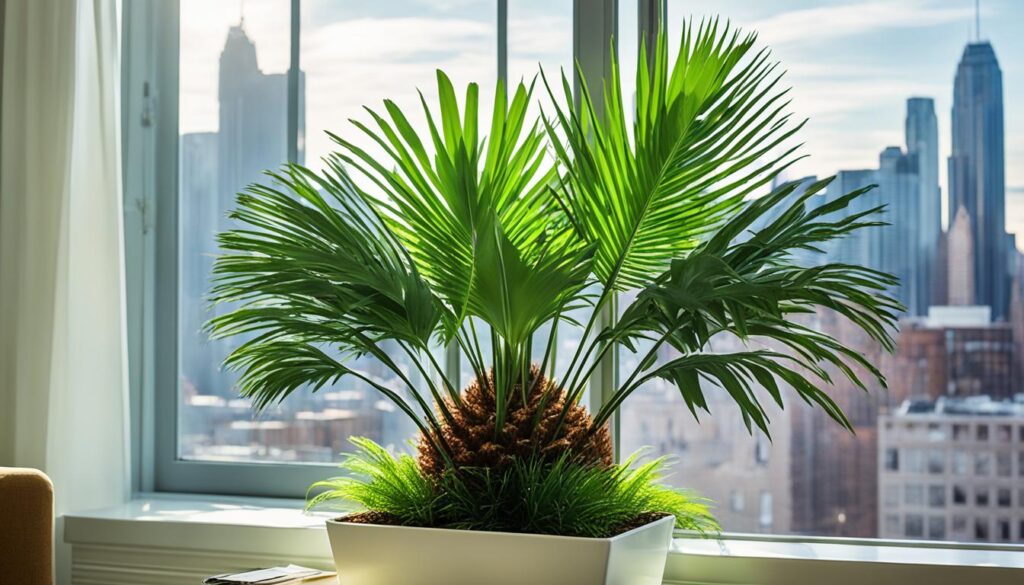
Is the Sago Palm Air-Purifying?
Yes, the Sago Palm cleans the air. It is great for apartments. This plant takes away bad toxins. Toxins like formaldehyde can be harmful to us.
Having one can make your air cleaner. This leads to a healthier home.
Is the Sago Palm Pet Friendly?
Yes, the Sago Palm is safe for pets. It is not toxic to cats and dogs. This is good for pet owners.
But always watch your pets around plants. Even though it’s safe, pets shouldn’t chew on it.
How Big Does the Sago Palm Get?
The Sago Palm’s size is well-suited for small apartments. It can grow up to 8 feet tall. But it grows slowly.
This slow growth keeps it a good size for your space. With care, you can keep it small.
How to Grow a Sago Palm – Learn to Grow this Indoor Beauty
Growing a Sago Palm indoors needs special care. You will learn how to make a Sago Palm grow well at home. We will talk about the best pot and soil, how much light it needs, and how to water it. We will also talk about food for the plant, how to cut it, and how to make more plants from it. Plus, we will tell you how to keep bugs and diseases away to keep your Sago Palm happy.
Choosing the Right Pot and Soil
It’s important to pick the right pot and soil for your Sago Palm. Your pot must have holes at the bottom. For soil, mix sand, peat moss, and perlite in equal parts. This mix drains well but keeps enough moisture.
Providing Adequate Light
Sago Palms like light, but not too much. Put your plant by a window that gets light but not direct sun. Sun can hurt the leaves. If it’s too dark, use a grow light to help your Sago Palm.
Watering and Humidity
Your Sago Palm needs the right amount of water. Wait for the top inch of soil to dry before watering. The amount you need to water changes with the weather and how humid it is. Sago Palms like a bit of humidity. You can put water near your plant or use a humidifier to help.
Nutrition and Fertilization
Feeding your Sago Palm helps it grow. Use a palm fertilizer when it’s growing, from spring to fall. Always check the package to know how much and how often to use it.
Pruning and Maintenance
Keep your Sago Palm tidy by cutting off dead leaves. Use clean tools to avoid getting the plant sick. Also, remove any small plants growing at the base to help the main plant grow better.
Propagation
You can make new Sago Palms from your plant. Use stem cuttings or divide the plant. Plant stem pieces in good soil or separate baby plants from the side. Use the method that you like best.
Monitoring for Pests and Diseases
Watch your Sago Palm for bugs and sickness. Common problems are mealybugs, scales, and spider mites. If you find bugs, use the right bug spray or natural methods. Also, watch out for diseases like root rot. Taking care of your plant and checking it can prevent these problems.
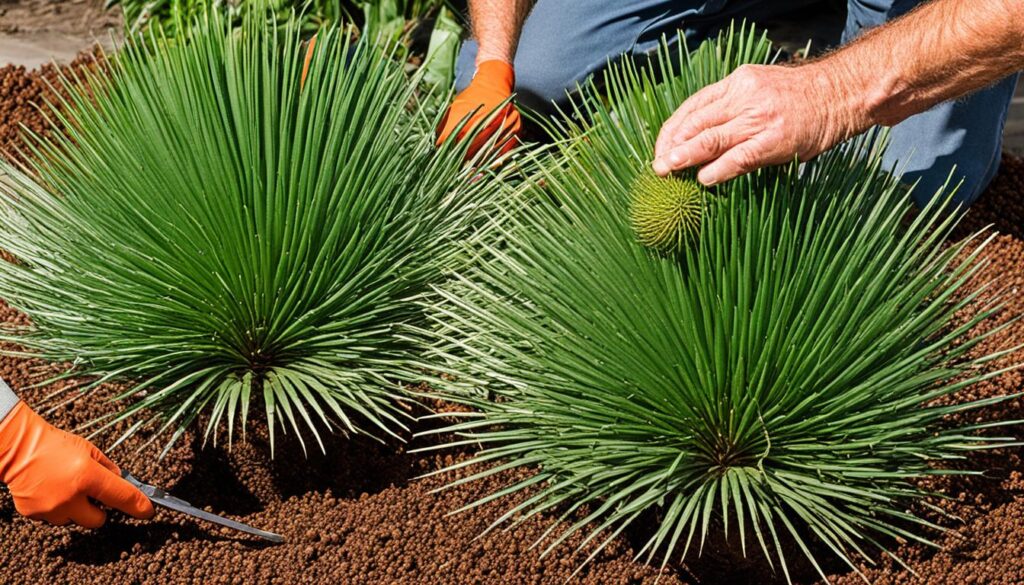
If you take care of your Sago Palm, it will grow big and beautiful in your apartment. Next, we’ll talk about what a Sago Palm looks like. We’ll show you its unique and tropical looks.
Appearance of Sago Palm
The Sago Palm, also known as Cycas revoluta, looks special and nice. It makes any space look like a tropical paradise. Its leaves are spiky, shiny, and a deep green color. They grow in a pattern that catches your eye. The plant also has thorns to protect itself, like a cactus.
This plant is known for how its new leaves grow. The new leaves look like bronze feathers. They grow in a circle. This makes the Sago Palm look very tropical and unique.

The picture above shows how pretty a Sago Palm is. You can see its spiky leaves and how they grow in a special way.
Light Requirements for Sago Palm
Sago palms need bright, indirect light to do well. Too much direct sun can hurt their leaves. It’s key to find a good middle ground.
To keep a sago palm happy inside, put it where it gets 4-6 hours of soft sunlight. A spot near an east or west window works well. This ensures it gets just the right light to grow strong.
For a picture showing the best light for a sago palm, see the image below:

Watering Requirements of the Sago Palm
Watering Sago Palms the right way is very important. It helps them stay healthy and look great. You need to find the perfect amount of water. Too much or too little is bad.
Water the palm when the top soil is dry. Make sure the soil gets a bit dry between watering. This stops root rot. Too much water makes leaves turn yellow or brown. It also causes root rot and fungus.
If you don’t water enough, the palm will get dry and not grow well. Always check if the soil needs water. Put your finger in the soil. If it feels dry, it’s time to water.
Don’t let the soil get too dry, though. Sago palms like their soil moist but not wet.
Tip: Drip irrigation is a great way to water. It gives water slowly to make sure roots get enough without too much water.
Signs of Overwatering vs. Underwatering
It’s key to know when your palm has too much or not enough water.
Signs of overwatering:
- Yellowing or browning of leaves
- Root rot
- Fungus growth
- Soggy or waterlogged soil
Signs of underwatering:
- Wilting
- Dehydration
- Stunted growth
- Dry and powdery soil
Watch your Sago Palm closely. Seeing these signs helps you water it just right.
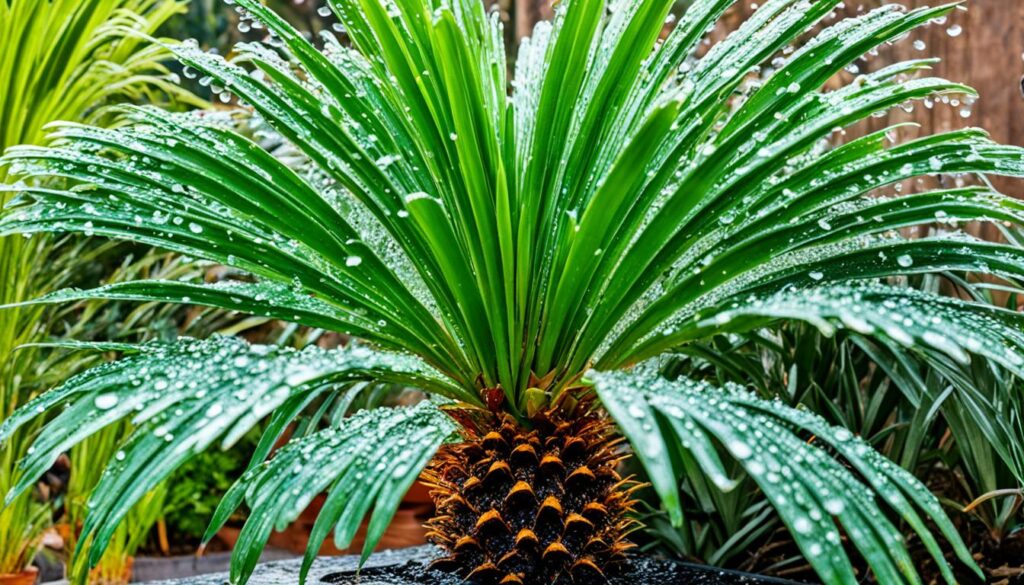
Fertilizing a Sago Palm
Fertilizing is key for a sago palm to grow well. It makes sure the plant stays healthy and looks beautiful.
Recommended Fertilizer for a Sago Palm
Use a slow-release fertilizer made for palms. It slowly gives the plant food over time.
You should put this fertilizer on your plant two or three times when it’s growing. The growing season is from spring to fall. This helps the sago palm get what it needs to grow.
Or, you can use a liquid food that has an 18-8-8 mix. This mix is good for the plant. If you use liquid, do it once a month during the growing season.
How much food to use depends on how big your plant is. Always follow the instructions on the package. Using too much can hurt your plant.
If you use the right food in the right amounts, your sago palm will grow strong inside.
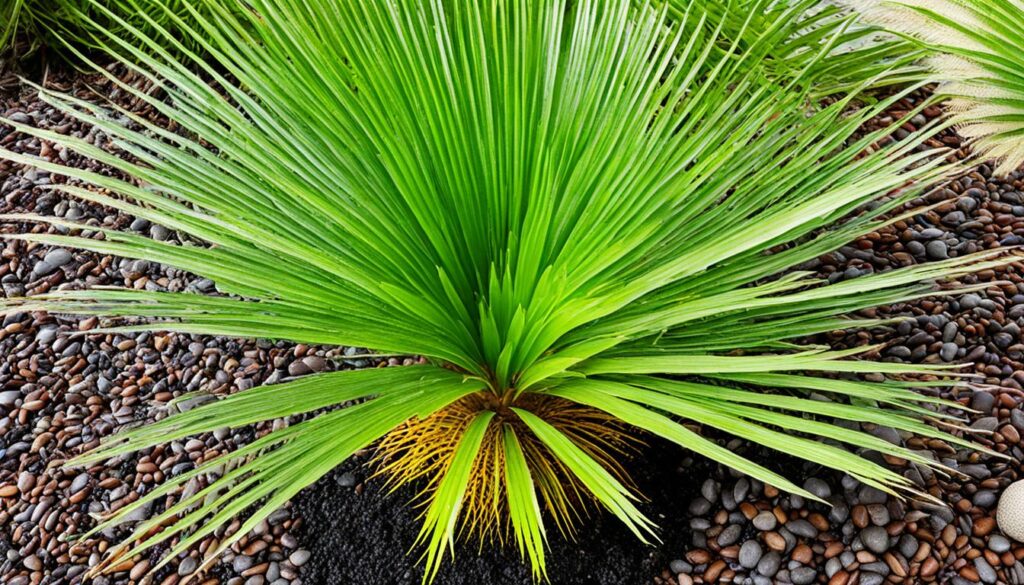
Potting a Sago Palm
Getting the potting right is key for a sago palm’s health and growth. I’ll show you how. We’ll cover finding the perfect pot size, choosing the best soil mix, and when to repot.
Choosing the Right Pot Size
Choose a pot a bit bigger than the plant’s root ball. This helps roots grow well. A too-small pot can squeeze roots. This slows down growth.
Using the Right Potting Mix for a Sago Palm
Having the best soil mix matters for your sago palm’s health. It needs to drain well but keep moisture. Mix sand, perlite, and peat moss for the best results. This mix stops roots from staying wet, which can cause rot.
Repotting When Necessary
Only repot if it’s really needed. Like if the pot is too tight or roots poke out of holes. Yellow leaves or slow growth also tell you it’s time to repot. Be careful not to hurt the roots when doing so.
Stick to these steps to make your sago palm happy and growing well.
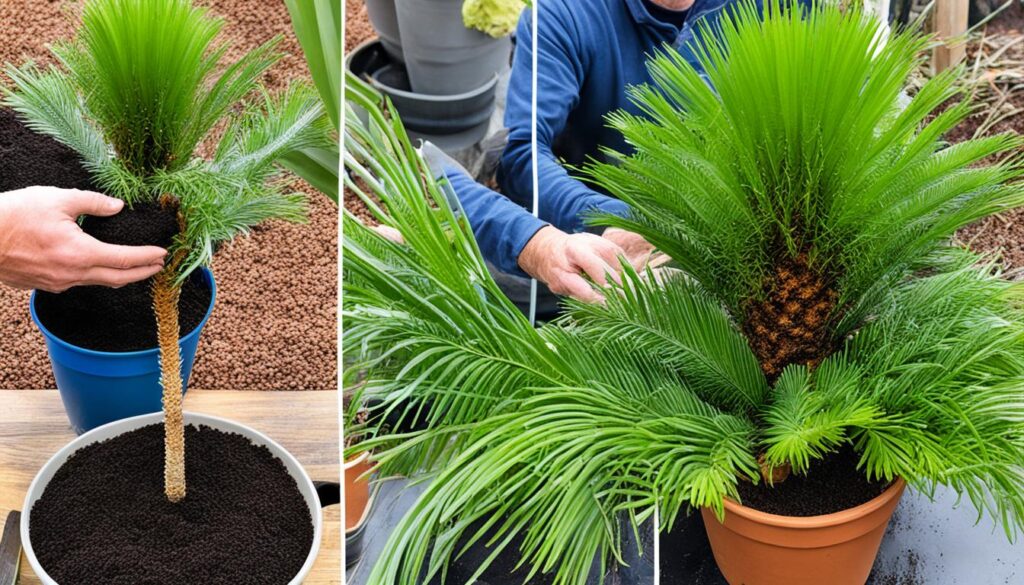
Propagating a Sago Palm
Propagating Sago Palms is an exciting way. You can expand your collection or share their beauty. You can use stem cuttings, seeds, or division. Let’s look at stem cuttings and division closely.
Stem Cuttings Or Seeds?
Propagating Sago Palms with stem cuttings is popular. It lets you make new plants from healthy ones. Choose a mature stem without disease or damage. With a clean tool, cut the stem. Make sure it has at least one leaf bud.
Next, get the growing medium ready. Use soil and perlite or sand. Dip the stem’s cut end in rooting hormone powder. This helps roots grow. Then, put it in the medium. Keep the soil moist. Place it where it gets bright, indirect light. In time, it will grow roots and can get its own pot.
But, using seeds to propagate takes longer. It needs patience and attention. Start with fresh seeds from a good place. Soak them in warm water for a day. This softens the husk. Then, plant them in sandy mix. Cover them lightly with soil. Keep them moist.
Place the seeds where it’s warm, about 80°F. Keep the air humid to help them sprout. Covering them or using a humidity dome works well. It takes months for them to germinate. During this, be patient and care for them well.
Division Of A Sago Palm
Division is another way to make more Sago Palms. It uses offshoots or pups from the plant. This is good if your plant has many offshoots. Or, if you want to make an old plant fresh again.
To divide, take the plant out of its pot carefully. Make sure not to hurt the roots. Gently take the offshoots apart from the main plant. Each one should have its own roots. You might need to cut connecting parts with a clean, sharp knife or shears.
After separating, plant each offshoot in its pot. Use well-draining soil. Take care of these new plants like a mature Sago Palm.
Propagating Sago Palms with stem cuttings or division is rewarding. You can grow your collection or share these beautiful plants. Whether by cuttings, seeds, or division, each way has benefits.
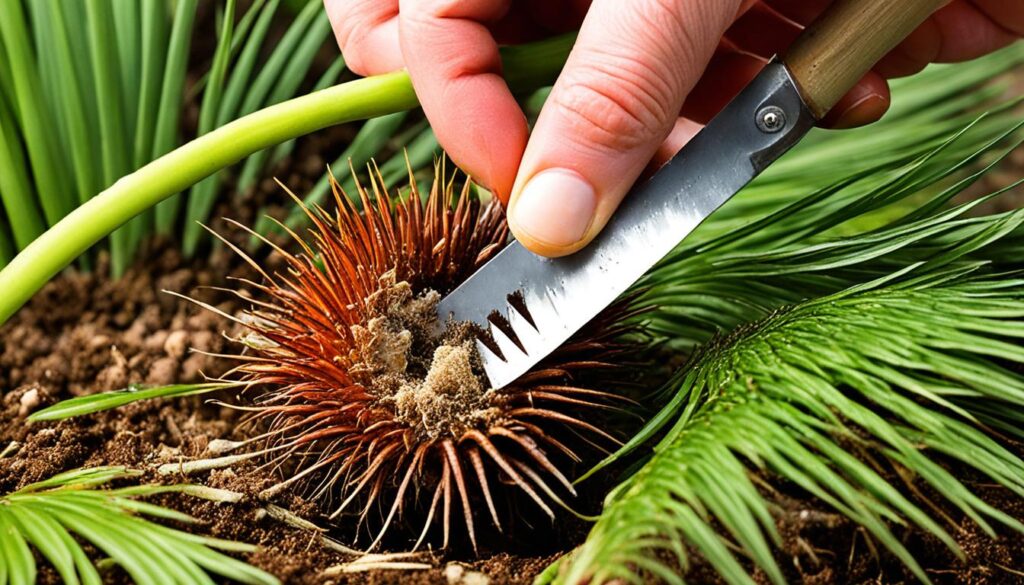
Growth and Development of the Sago Palm
Sago palms are very special plants. They grow in a unique way and develop slowly. They take many years to get as tall as 8 feet. How fast a Sago Palm grows depends on its surroundings, nutrients, and care.
It’s important to create the perfect place for a Sago Palm to grow well. They need the right amount of light, water, and nutrients to be healthy.
Watching a Sago Palm grow is exciting. As they get older, they get a pretty crown of dark green, spiky leaves. They start with bronze, soft-looking leaves. This makes them look nice and tropical. That’s why many people like them for indoor gardens.

To help your Sago Palm grow, you need to know what it needs at each stage. If you take good care of it and watch it closely, your Sago Palm will do great. It will look wonderful in your home.
Dealing with Pests and Diseases in the Sago Palm
Sago palms can get sick from pests and diseases. It’s key to keep an eye out and act early to protect them. Pests like mealybugs, scales, and spider mites can harm the plant.
To spot these pests, check your sago palm often. Look for cottony bugs or oval insects on leaves. Spider mites make webs and discolored leaves. See these signs? Act fast to stop more damage.
To fight pests, you can use natural ways or helpful bugs. Ladybugs and lacewings eat harmful pests. Or, clean pests off with a damp cloth or cotton swab.
If pests don’t go away, you might need chemicals. Ask a pro or a garden shop for the right bug killer for sago palms. Be sure to follow the directions and stay safe.
Sago palms can also get sick from root rot and sooty mold. These come from too much water, bad drainage, or other issues.
Keep your sago palm healthy by watering right and draining well. Let soil dry a bit between waterings. Check roots for signs of rot. Change how you water if you find problems.
Check leaves for sooty mold too. It’s a black powder that happens with some bugs. Get rid of the bugs to get rid of the mold.
Common Sago Palm Pests
Sago palms can get bugs that hurt their health. It’s important to know and fix bug issues to keep your palm healthy.
Mealybugs, scales, and spider mites often bug sago palms.
Mealybugs look white and fluffy. They eat plant juice, making growth slow and leaves yellow.
Scales can be white or brown. They stick to parts of the palm and suck its juice.
Spider mites are very small. They spin webs and eat leaf undersides. This makes leaves discolor and webs form.
To fight these pests, you must take steps. You can try different ways:
- Cultural methods: Check your palm for bugs often. Remove sick leaves or bugs by hand. Keep your palm clean.
- Natural predators: Put ladybugs or lacewings in your garden. They eat harmful bugs like mealybugs and scales.
- Organic insecticides: Use safe organic sprays if there are a lot of bugs. Follow the spray instructions carefully.
Natural Predators
Dealing with pests in your Sago Palm? Try natural methods. Introduce ladybugs and lacewings to eat pests like mealybugs and scales.
Attract these helpers to balance your garden’s ecosystem. Buy them or make your garden welcoming with flowers or bug hotels.
Isolate Infected Plants
See a pest-infested Sago Palm? Keep it away from others. This stops pests from spreading.
Move the sick plant until it’s pest-free. This protects your garden’s health.
Chemical Treatment
Sometimes, bugs outnumber natural predators. Then, you might need chemicals for the pests.
Be careful with chemicals. Wear safety gear and follow the label. Pick safe products for Sago Palms and mind the waiting time.
Use nature’s help, isolate troubled plants, and apply chemicals if needed. This keeps your Sago Palms healthy and beautiful.
Disease Prevention For Sago Palms
Keeping sago palms disease-free is key to their health. It’s important to practice disease prevention.
Good watering and drainage are vital. Sago palms need well-draining soil. This helps stop root rot and fungal diseases.
You should not overwater them. Let the soil dry a bit before watering again. This stops diseases.
Keeping the area clean and airy helps too. Remove dead leaves to fight pests and diseases.
Check your plant for signs of sickness. Look for yellow leaves or spots. Finding problems early helps a lot.
These steps help keep your sago palm healthy. You’ll lower disease risks.
Tips for Maintaining Sago Palms
Maintaining sago palms helps them stay healthy and last longer. Follow some tips to keep your palm looking good.
Wiping Leaves
Wipe your palm’s leaves with a wet cloth regularly. This removes dust and helps the plant use sunlight better. Clean leaves mean a happier plant.
Outdoor Exposure
If you put your sago palm outside, protect it from too much sun and bad weather. They can handle some sun, but not too much. Pick a spot that’s not too windy or rainy.
Adjusting Watering Schedule
Change how much you water your palm as the seasons change. Water more when it’s hot and the plant is growing. Water less when it’s cold or the plant isn’t growing. This keeps the moisture level just right.
Keep your palm clean, in the right spot outside, and water it well. This will help it stay healthy and look great in your home. Additionally, ensure that it receives indirect sunlight to maintain its vibrant green foliage. Regularly dusting the leaves will also enhance photosynthesis and overall growth. For those looking to enhance their plant care routine, here are some essential areca palm care tips to keep your palm thriving.
Tips for Successful Overwintering of Sago Palm
Keeping sago palms safe in winter is tough. They don’t like the cold. When it gets colder than 50°F, bring your sago palm inside. Pick a spot where it gets enough light and humidity.
Avoid putting your sago palm where it’s drafty or too hot. Don’t place it near air vents or heaters. This can upset the plant. A humidifier or a tray of water can help keep the air moist.
Watch the soil’s moisture level in winter. Sago palms don’t need much water then. But the soil shouldn’t get totally dry. Check the soil often. Water it a bit if it needs it.
By doing these things, you’ll help your sago palm make it through winter. Proper care lets your plant stay healthy. With the right steps, your sago palm will be all set for spring.
Growing Sago Palm from Seed
Growing a Sago Palm from seeds is fun but it takes time and focus. Start with good seeds and do the right steps. Then, you can grow your own Sago Palm from a seed.
Here’s how to grow a Sago Palm from a seed:
- Use high-quality seeds from a trusted place. This makes sure your seeds will grow.
- Soak the seeds for a day to soften their outer layer. This makes them sprout faster.
- Use a sandy, well-draining mix for planting your seeds. It’s best for starting seeds.
- Put the seeds an inch deep in the mix.
- Keep the pot in a warm place, 80-90°F (27-32°C). Warmth helps with sprouting.
- Water the soil so it’s moist but not too wet. This is important while seeds sprout.
- Sprouting takes time, often months. Be patient and take good care of them.
Getting a Sago Palm to grow from a seed means being careful and dedicated. By taking the right steps and making conditions perfect, you will enjoy watching your Sago Palm grow from a seed.
Varieties of Sago Palm
Sago palms come in different types. Each one has its own special look.
Some people love the big king sago palm. Others prefer the queen sago’s elegant look. Or the true sago palm, which is useful and pretty for indoor gardens.
The king sago palm is tough and looks bold. It’s liked by many for indoor spaces. Its strong leaves can handle different places, making it great for apartments.
If you want something pretty, check out the queen sago palms. They have gentle leaves that flow. They bring a feeling of beauty and grace.
The true sago palm is great for looks and uses. It brings a tropical feel inside. Plus, it makes an edible starch for cooking.
Looking at different sago palms helps you pick the right one. Any sago palm adds nature’s charm. It will be a lovely spot in your apartment.
FAQ
Q: Why do we love the Sago Palm for apartments?
A: The Sago Palm makes apartments look tropical. It cleans the air and is safe for pets. It’s also small, perfect for tight spaces.
Q: Is the Sago Palm air-purifying?
A: Yes, Sago Palms clean the air. They take out bad toxins and make the air better.
Q: Is the Sago Palm pet-friendly?
A: Yes, Sago Palms are safe for pets. You don’t have to worry about your furry friends.
Q: How big does the Sago Palm get?
A: Sago Palms can grow up to 8 feet tall. They grow slow so they don’t get too big too fast.
Q: How to grow a Sago Palm?
A: For a Sago Palm, pick the right pot and soil. Make sure it gets enough light.
Water it right and keep the air humid. Feed it with fertilizer and take care of it. Learn how to make more plants from it.
Q: What pot and soil should I choose?
A: Pick a pot a bit bigger than the root ball. Use soil that drains well with sand, perlite, and peat moss.
Q: What light does the Sago Palm need?
A: Sago Palms need light but not direct sun. A window facing east or west is best.
Q: How should I water and provide humidity for the Sago Palm?
A: Let the soil dry a bit before watering again. Use a mister or humidifier to help.
Q: How should I fertilize my Sago Palm?
A: Use a palm fertilizer slowly over time. Or give it liquid food once a month.
Q: How do I prune and maintain my Sago Palm?
A: Clean the leaves gently. Keep it safe from too much sun and bad weather. Change how much you water with the seasons.
Q: How can I propagate a Sago Palm?
A: You can make new plants from stems, seeds, or side shoots. Each way works differently.
Q: How can I monitor and handle pests and diseases?
A: Always check for bugs and sickness. If you find any, take care of it fast. Use bug eaters or safe chemicals if needed.
Q: What are common pests that affect Sago Palms?
A: Watch out for mealybugs, scales, and spider mites on your palm.
Q: How can I prevent diseases in Sago Palms?
A: Water it right and keep the air moving. Always keep an eye out for sick plants.
Q: What are some tips for maintaining Sago Palms?
A: Clean the leaves. Protect from too much sun. Water more or less with the weather.
Q: How can I successfully overwinter my Sago Palm?
A: Bring it inside if it gets colder than 50°F. Keep it humid and in good light. Keep it away from cold drafts and big temperature changes.
Q: How can I grow a Sago Palm from seed?
A: Start with good seeds. Soak them, then plant in sand. Keep them warm and moist. It might take a while to see them grow.
Q: What are the different varieties of Sago Palm?
A: There are many kinds like the king sago and queen sago. Each one looks a bit different.

